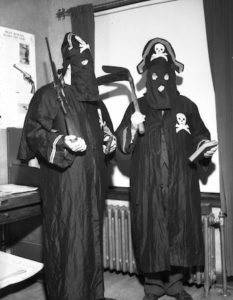
*The Black Legion is affirmed on this date in 1915. They were a white supremacist terrorist organization active in the Midwestern United States during the Great Depression of the 1930s.
In 1915, the release of D. W. Griffith's film, The Birth of a Nation, inspired a revival of the Ku Klux Klan (KKK) in Atlanta, Georgia. Gradually, the new Klan, often appealing to migrants to cities as a fraternal order, established new chapters nationwide, particularly in urban areas, including the rapidly changing cities of the industrial Midwest.
Throughout the 1920s, cities such as Detroit, Cleveland, and Indianapolis were centers of an increase in Klan membership and activity in local chapters in reaction to high rates of immigration from Eastern and Southern Europe and internal migration of Blacks from the South. A sexual scandal in the national leadership in 1925 and local actions by opponents determined to unmask members' secrecy caused membership to drop rapidly through the late 1920s.
Initially, the Black Legion was part of the Klan. It was founded by William Shepard in the 1920s as a paramilitary force called the Black Guard in the Appalachian region of East Central Ohio. Its original mission was to protect regional Klan officers. The Black Legion formed chapters all across Ohio and expanded into other areas of the Midwestern United States. One of its self-described leaders, Virgil "Bert" Effinger, lived and worked in Lima, Ohio. It split off from the Klan.
According to historian Rick Perlstein, the FBI estimated its membership "at 135,000, including a large number of public officials, possibly including Detroit’s police chief." Like the Klan, the Black Legion was composed mainly of white-American-born, working-class, Protestant white men in the Midwest. These men feared the rapid social changes underway and resented competition with immigrants such as Italians and Jews and migrants in the industrial economy of major cities such as Detroit. Their enemies list "included all immigrants, Catholics, Jews, and Blacks, nontraditional Protestant faiths, labor unions, farm cooperatives, and various fraternal groups."
Membership was concentrated in Michigan and Ohio. Black Legion members established a network for securing jobs and gaining influence. In addition, as a secret vigilante group, the Legion members operated in gangs to enforce their view of society, sometimes attacking immigrants to intimidate them at work or to enforce their idea of moral behavior. They generally opposed socialism and union organizing. They had a reputation for frequent violence against alleged political or social enemies. In 1931, Arthur F. Lupp, Sr. of that community, formed a chapter of the Black Legion in Highland Park, Michigan. Throughout and perhaps fueled by the economic and social upheaval of the Great Depression, the Black Legion expanded across Michigan until the mid-1930s, when its estimated membership peaked at between 20,000 and 30,000.
Generally, Black Legion members in the state were native-born, Protestant men. One-third of its members lived in Detroit, which had also been an intense center of Klan activity in the 1920s. The Michigan Legion was organized along military lines, with five brigades, 16 regiments, 64 battalions, and 256 companies. From 1933 to 1936, they were rumored to be responsible for some unsolved deaths that had officially been attributed to suicide or unknown perpetrators. In 1936, the group was suspected of having killed as many as 50 people, according to the Associated Press, including Charles Poole, an organizer for the federal Works Progress Administration. At the time of Poole's murder, the Associated Press described the organization as "A group of loosely federated night-riding bands operating in several States without central discipline or common purpose beyond the enforcement by lash and pistol of individual leaders' notions of 'Americanism.'"
Based on testimony in the trial of Poole's killer, Dayton Dean, Wayne County Prosecutor Duncan McRae conducted a widespread investigation and prosecuted another 37 men suspected of Legion murders and assaults. All were convicted and sentenced to prison. These cases and associated adverse publicity resulted in a rapid decline in Legion membership. The sensational cases inspired two related films, one starring Humphrey Bogart, and two radio show episodes from 1936 to 1938.